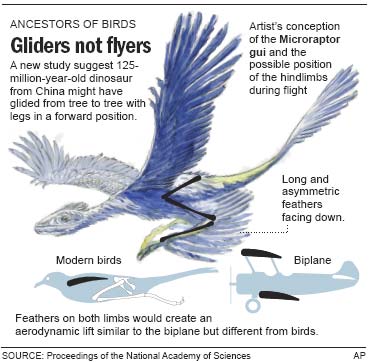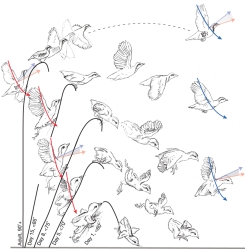Ever since Archaeopteryx was discovered (at least) evolutionary biologists and naturalists have been fascinated with the question of “How and why did avian flight evolve”. It has been a puzzling question, because while Darwin could plausibly suggest the usefulness of “half an eye” for the gradual natural selection of the vertebrate eye, he could not do so for “half a wing.”
Observations that feathers are excellent thermal insulators, or provide an excellent means of coloration for sexual selection, may explain the development of early proto-feathers, but those observations do not themselves provide an explanation for the partially aerodynamic characteristics of those proto-feathers, or for primitive wing mechanics. Somehow, these structures must have had some intermediate function.
There have been a lot of variations in theories on the origin of flight since the 1860’s, but most people nowadays group them generally into two categories. The first, the Cursorial model, proposed that flight evolved in running bipeds through a series of short jumps. Meanwhile the second, the Arboreal Model, proposed that those pre-avian dinosaurs (theropods) where gliders originally, much like “flying” squirrels today.
The Arboreal Model
Support for the Arboreal Model focuses on the observation that at least some of the feathered theropods, like Archaeopteryx, appear to have had feathers on all four limbs. By orientating their limbs in a biplane wing orientation, feathered theropods may have been capable of gliding and even generating lift. Moreover, feathered hindlimbs would serve no purpose for theropods running on the ground, and would theoretically impede locomotion during running.
With hindlimb feathers, as well as flight muscles less developed than those of present day birds, Archaeopteryx may have not been able to take off from the ground. Microraptor gui, a more recent and even more pronounced “four-winged dinosaur”, suggested that feathered hindwings were indeed prevalent in the dinosaurs that gave rise to birds, and strengthened the “bi-plane wing orientation” hypothesis Chatterjee and Templin, 2007.

However, critics of this theory argue that it has little support from comparative biology as it requires the ability to climb trees (Padian and Chiappe, 1998). Neither capacity seems to be present in Archaeopteryx or in related theropods. Archaeopteryx has none of the features of typical vertebrate gliders, including the observation that the airfoil surfaces (the wings) are distal from the torso, where better used not for maintaining loft but for generating lift. Also, paleobotanical evidence shows an absence of large trees anywhere near the Solnhofen lagoons in which Archaeopteryx is preserved.
The Cursorial Model
The Cursorial Model is based two primary observations. First, the functional-ecological observation that Archaeopteryx was a strong, agile biped, given the functional morphology of its skeleton. And secondly, the observation that birds evolved from small, active, running predators (Burgers and Chiappe, 1999).
Running only brings a potential flyer so far however – eventually birds (obviously) developed the flight stroke – which is where the major criticisms of the Cursorial Model have entered in. Three issues have contributed to this lack of success: the gap between the estimated maximum running speed of Archaeopteryx (2 m/s) and its estimated minimum flying speed (6 m/s); the high energy demands of evolving flight against gravity; and the problem of explaining the origin of the flight stroke in an earthbound animal (Chatterjee and Templin, 2003).
Wing-Assisted Incline Running
So basically, there are significant criticisms of the Arboreal Model from the anatomists, and even more damning criticisms of the Cursorial Model from biomechanics simulations. It would seem that both theories as they have been popularly expressed are inadequate. This is where the famous words of scientific discovery came in. No, not “Eureka”, but “That’s odd…”:
University of Montana researcher [Ken Dial] and two grad students were working in the University’s Flight Laboratory, a high-tech avian research facility at Fort Missoula. […]
One of his grad students, Paolo Segre, was putting the birds through their paces and recording the results. He somewhat sheepishly reported to Dial that the avians – in this case chukar partridges – weren’t really changing their wing angle as they flew higher, descended or flapped their wings to help them run up steep surfaces.
“You’re full of soot,” Dial responded. (Actually he didn’t quite say that. Anyone who has worked in the lab with Dial long enough knows his language gets a bit more salty.) “Go back and do it again. This can’t be right. The physics doesn’t make sense.”
But when the chastened Segre tried again, this time with the help of the other student, Brandon Jackson, results were similar. Soon Dial was involved, and all scratched their heads as they watched videos of the birds perform in ultra-slow motion. Something wasn’t right …
“Then all three of us went, ‘Holy —-! They really aren’t changing their wing angle!’” Dial said. “Then we stopped to think about how that could be. And we realized we had to rethink what we were imagining the birds were doing.”
For an more visual explanation, here’s a YouTube clip that makes it clear:
So what good is half a wing anyway?
While Dial’s 2008 Nature paper, A fundamental avian wing-stroke provides a new perspective on the evolution of flight, provides the complete scientific argument for Dial’s new theory, he explains the repercussions candidly in the ScienceDaily article:
Now Dial and his crew have discovered in the laboratory that half a wing indeed can be useful. He has entered the evolution-of-flight fray by offering a third rival idea – the ontogenetic transitional wing hypothesis, or OTWH. (Ontogenetic means the development of something.) This theory suggests that birds evolved incrementally by using their half-developed wings to run up steep surfaces (WAIR) and gained a survival advantage. Then they flapped their proto-wings to return to the ground safely. And, by the way, it’s no great leap to cross between these behaviors because they are linked by a fundamental, constant wing angle.
“We think our theory is a convergence of thought that’s a more complex marriage of the arboreal or cursorial camps,” Dial said. “We have taken the beautiful sage elements from each one, and I feel we integrated them perfectly to say you never needed to go strictly from the ground up or tree down.”
So feathered dinosaurs really could have had their cake and eaten it too, running AND gliding to flight. And, importantly, explorations of the ontogeny of post-natal behavior and morphology among extant taxa appear to provide insight into ecological and evolutionary locomotor transitional stages. Ontogeny doesn’t recapitulate phylogeny, but by studying extant morphologies and behaviors, we can make at least a handful of inferences regarding the morphologies and behaviors that they were derived from.
And, just looking at this last image for my post (Fig. 1 from Dial et al., 2008), it is hard not to recognize the plausibility that Archaeopteryx and Microraptor flapped their feathered forelimbs similarly.
References
- Chatterjee & Templin (2007) Biplane wing planform and flight performance of the feathered dinosaur Microraptor gui. Proc. Natl. Acad. Sci. 104: p1576-1580
- Padian & Chiappe (1998) The origin and early evolution of birds. Biological Reviews 73: p1-42
- Burgers & Chiappe (1999) The wing of Archaeopteryx as a primary thrust generator. Nature 399: p60-62
- Chatterjee & Templin (2003) The flight of Archaeopteryx. Naturwissenschaften 90: p27-32
- Dial, et al. (2008) A fundamental avian wing-stroke provides a new perspective on the evolution of flight. Nature 451: p985-989



[…] sauciest one muttered about half a wing being useless, but Migration demonstrated that half a wing is useful indeed. The final straw was when the Evolving Mind noted that evolution does not inevitably lead to […]
By: Carnival of Evolution #10 « The Oyster’s Garter on April 1, 2009
at 8:30 pm
Why do they jump to half a wing right away? What about 1/5 of a wing? What use is that? :))
By: atman on May 30, 2009
at 6:21 pm